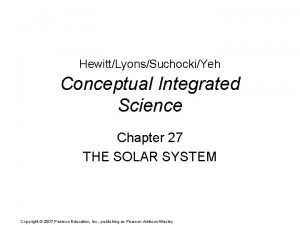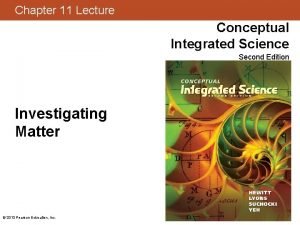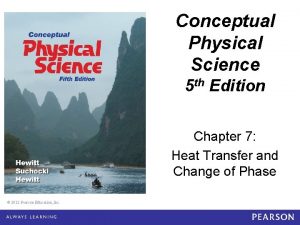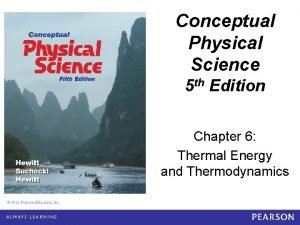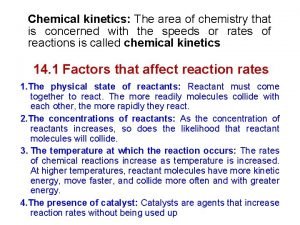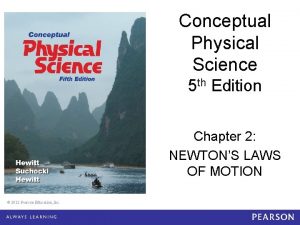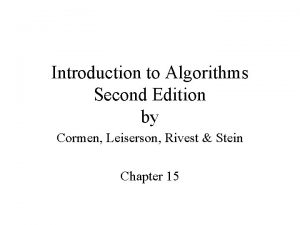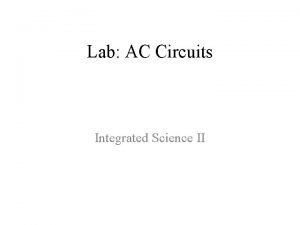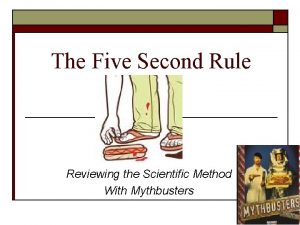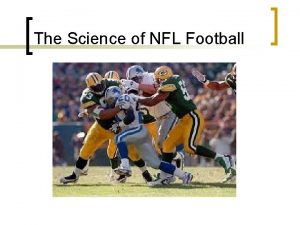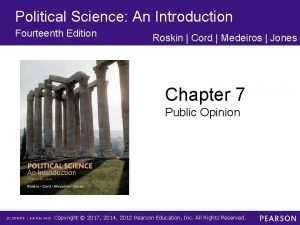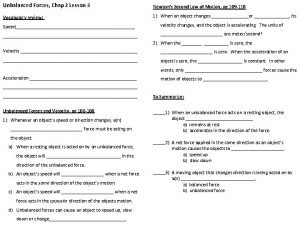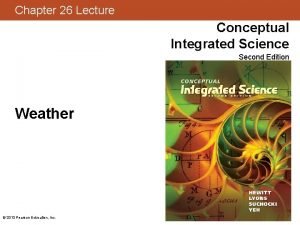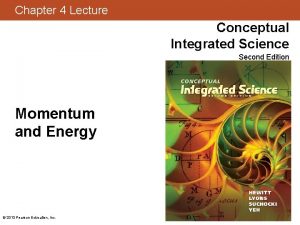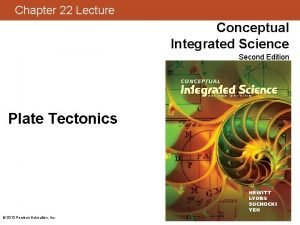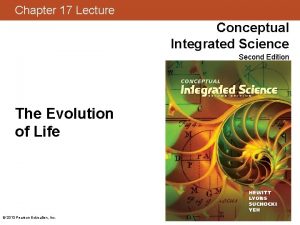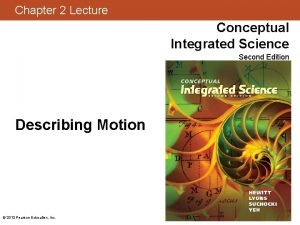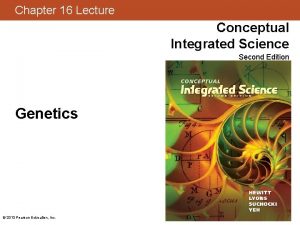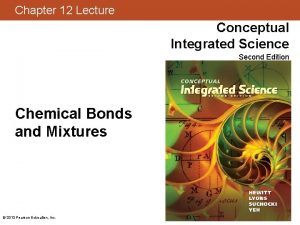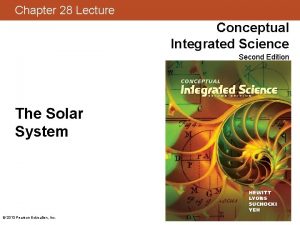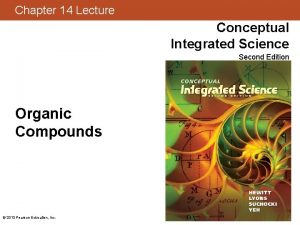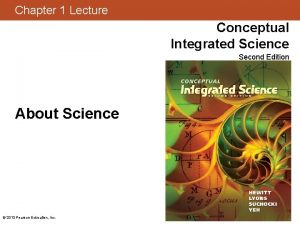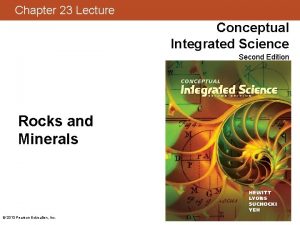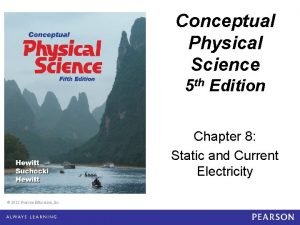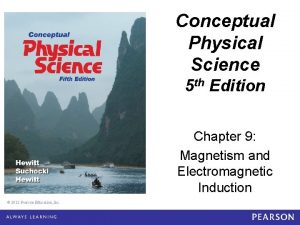Chapter 3 Lecture Conceptual Integrated Science Second Edition



















































- Slides: 51

Chapter 3 Lecture Conceptual Integrated Science Second Edition Newton's Laws of Motion © 2013 Pearson Education, Inc.

This lecture will help you understand: • • • Newton's First Law of Motion Newton's Second Law of Motion Forces and Interactions Newton's Third Law of Motion Vectors © 2013 Pearson Education, Inc.

Newton's First Law of Motion • The law of inertia: – Every object continues in a state of rest or of uniform speed in a straight line unless acted on by a nonzero force. © 2013 Pearson Education, Inc.

Newton's First Law of Motion CHECK YOUR NEIGHBOR A sheet of paper can be quickly withdrawn from under a soft-drink can without the can toppling because A. gravity pulls harder on the can than on the paper. B. the can has weight. C. the can has inertia. D. none of the above Explain your answer to your neighbor. © 2013 Pearson Education, Inc.

Newton's First Law of Motion CHECK YOUR NEIGHBOR If you swing a stone overhead in a horizontal circle and the string breaks, the tendency of the stone is to follow a A. B. C. D. curved path. straight-line path. spiral path. vertical path. Explain your answer to your neighbor. © 2013 Pearson Education, Inc.

Newton's Second Law of Motion • The law of acceleration: – The acceleration produced by a net force on an object is directly proportional to the net force, is in the same direction as the net force, and is inversely proportional to the mass of the object. © 2013 Pearson Education, Inc.

© 2013 Pearson Education, Inc.

Newton's Second Law of Motion • Equation for acceleration: Small net force, large mass small acceleration Large net © 2013 Pearson Education, Inc. force, small mass large acceleration

Newton's Second Law of Motion CHECK YOUR NEIGHBOR Consider a cart pushed along a track with a certain force. If the force remains the same while the mass of the cart decreases to half, the acceleration of the cart will A. B. C. D. remain the same. halve. double. change unpredictably. Explain your answer to your neighbor. © 2013 Pearson Education, Inc.

Newton's Second Law of Motion CHECK YOUR NEIGHBOR Push a cart along a track so that twice as much net force acts on it. If the acceleration remains the same, what is a reasonable explanation? A. The mass of the cart doubles when the force is doubled. B. The cart experiences a force that it didn't before. C. The track is not level. D. Friction reverses the direction. Explain your answer to your neighbor. © 2013 Pearson Education, Inc.

Newton's Second Law of Motion When acceleration is g—free fall 9. 8 m/s 2 • When the only force acting on a falling object is gravity (with negligible air resistance), the object is in free fall. • An object in free fall accelerates toward Earth at 10 m/s per second. (9. 8 m/s 2 precisely or 32 ft/s 2) © 2013 Pearson Education, Inc.

Newton's Second Law of Motion CHECK YOUR NEIGHBOR At one instant, an object in free fall has a speed of 40 m/s. Its speed one second later will be A. B. C. D. also 40 m/s. 45 m/s. 50 m/s. none of the above Explain your answer to your neighbor. © 2013 Pearson Education, Inc.

Newton's Second Law of Motion • When acceleration is g—free fall Twice the force on twice the mass same acceleration as half the force on half the mass © 2013 Pearson Education, Inc.

Newton's Second Law of Motion CHECK YOUR NEIGHBOR A 5 -kg iron ball and a 10 -kg iron ball are dropped from rest. With negligible air resistance, the acceleration of the heavier ball will be A. B. C. D. less. the same. greater. undetermined. Explain your answer to your neighbor. © 2013 Pearson Education, Inc.

Newton's Second Law of Motion CHECK YOUR NEIGHBOR A 5 -kg iron ball and a 10 -kg iron ball are dropped from rest. When the free-falling 5 -kg ball reaches a speed of 10 m/s, the speed of the free-falling 10 -kg ball will be A. B. C. D. less than 10 m/s. greater than 10 m/s. undetermined. Explain your answer to your neighbor. © 2013 Pearson Education, Inc.

Newton's Second Law of Motion • When acceleration is g—free fall – The ratio of weight to mass is the same for all falling objects in the same locality; hence, their accelerations are the same in the absence of air resistance. © 2013 Pearson Education, Inc.

Newton's Second Law of Motion • When acceleration is g—free fall • Demonstration of a feather and a coin in a vacuum: • In a vacuum, a feather and a coin fall together at g—the acceleration due to gravity. © 2013 Pearson Education, Inc.

Newton's Second Law of Motion A situation to ponder… • When an air-filled glass tube containing a coin and a feather is inverted, the coin falls quickly to the bottom of the tube while the feather flutters to the bottom. © 2013 Pearson Education, Inc.

A situation to ponder… CHECK YOUR NEIGHBOR When the air is removed by a vacuum pump and the activity is repeated, A. the feather hits the bottom first, before the coin hits. B. the coin hits the bottom first, before the feather hits. C. both the coin and the feather drop together, side by side. D. There is not enough information. Explain your answer to your neighbor. © 2013 Pearson Education, Inc.

Newton's Second Law of Motion • When acceleration is less than g— non-free fall • When two forces act on a falling object, – a force due to gravity acts downward. – air resistance acts upward. © 2013 Pearson Education, Inc.

Newton's Second Law of Motion CHECK YOUR NEIGHBOR When a 20 -N falling object encounters 5 N of air resistance, its acceleration of fall is A. B. C. D. less than g. greater than g. g. terminated. Explain your answer to your neighbor. © 2013 Pearson Education, Inc.

Newton's Second Law of Motion • When acceleration is less than g—non-free fall • The force exerted by the surrounding air increases with the increasing falling speed. • The force of air resistance may continue to increase until it equals the weight. At this point, the net force is zero and no further acceleration occurs. The object has reached terminal velocity and continues to fall with no acceleration—at constant velocity. © 2013 Pearson Education, Inc.

Newton's Second Law of Motion • Terminal Velocity is when the Net force is zero. • Net Force = Weight – Air Resistance • Terminal Velocity means that the object can no longer gain speed. © 2013 Pearson Education, Inc.

Newton's Second Law of Motion © 2013 Pearson Education, Inc.

Newton's Second Law of Motion CHECK YOUR NEIGHBOR If a 50 -N person is to fall at terminal speed, the air resistance needed is A. B. C. D. less than 50 N. greater than 50 N. none of the above Explain your answer to your neighbor. © 2013 Pearson Education, Inc.

Newton's Second Law of Motion CHECK YOUR NEIGHBOR As the skydiver falls faster and faster through the air, the air resistance A. B. C. D. increases. decreases. remains the same. There is not enough information. Explain your answer to your neighbor. © 2013 Pearson Education, Inc.

Newton's Second Law of Motion CHECK YOUR NEIGHBOR As the skydiver continues to fall faster and faster through the air, the net force A. B. C. D. increases. decreases. remains the same. There is not enough information. Explain your answer to your neighbor. © 2013 Pearson Education, Inc.

Newton's Second Law of Motion CHECK YOUR NEIGHBOR As the skydiver continues to fall faster and faster through the air, her acceleration A. B. C. D. increases. decreases. remains the same. There is not enough information. Explain your answer to your neighbor. © 2013 Pearson Education, Inc.

Newton's Second Law of Motion A situation to ponder… • Consider a heavy and a light person with samesize parachutes jumping together from the same altitude. © 2013 Pearson Education, Inc.

A situation to ponder… CHECK YOUR NEIGHBOR Who will reach the ground first? A. B. C. D. The light person The heavy person Both at the same time There is not enough information. Explain your answer to your neighbor. © 2013 Pearson Education, Inc.

Forces and Interactions • Force is simply a push or a pull. Interaction occurs between one thing and another. Example: When you push against a wall, you're interacting with the wall. © 2013 Pearson Education, Inc.

Newton's Third Law of Motion • Law of action and reaction: Whenever one object exerts a force on a second object, the second object exerts an equal and opposite force on the first. Example: When your hand presses on the wall, the wall simultaneously presses on your hand. Hand wall press on each other with equal and opposite forces. © 2013 Pearson Education, Inc.

Newton's Third Law of Motion CHECK YOUR NEIGHBOR A soccer player kicks a ball with 1500 N of force. The ball exerts a reaction force against the player's foot of A. B. C. D. somewhat less than 1500 N. somewhat greater than 1500 N. none of the above Explain your answer to your neighbor. © 2013 Pearson Education, Inc.

Newton's Third Law of Motion • Simple rule to identify action and reaction Action: Object A exerts a force on object B. Reaction: Object B exerts a force on object A. © 2013 Pearson Education, Inc.

Newton's Third Law of Motion CHECK YOUR NEIGHBOR When you step off a curb, Earth pulls you downward. The reaction to this force is A. B. C. D. a slight air resistance. nonexistent in this case. you pull the Earth upward. none of the above Explain your answer to your neighbor. © 2013 Pearson Education, Inc.

Newton's Third Law of Motion • Action and reaction on different masses If the same force is applied to two objects of different masses, Greater mass object small acceleration Smaller mass object large acceleration © 2013 Pearson Education, Inc.

Newton's Third Law of Motion • Locomotion on land, what do you notice? © 2013 Pearson Education, Inc.

Newton's Third Law of Motion CHECK YOUR NEIGHBOR When a cannon is fired, the accelerations of the cannon and cannonball are different because the A. forces don't occur at the same time. B. forces, though theoretically the same, in practice aren't the same. C. masses are different. D. ratios of force to mass are the same. Explain your answer to your neighbor. © 2013 Pearson Education, Inc.

Newton's Third Law of Motion A situation to ponder… • Consider a high-speed bus colliding head-on with an innocent bug. The force of impact splatters the unfortunate bug over the windshield. © 2013 Pearson Education, Inc.

A situation to ponder… CHECK YOUR NEIGHBOR Which is greater: the force on the bug or the force on the bus? A. B. C. D. Bug Bus Both forces are the same. Cannot say Explain your answer to your neighbor. © 2013 Pearson Education, Inc.

Newton's Third Law of Motion CHECK YOUR NEIGHBOR Two people of equal mass on slippery ice push off from each other. Will both move at the same speed in opposite directions? A. B. C. D. Yes, but only if both push equally No No, unless acceleration occurs Explain your answer to your neighbor. © 2013 Pearson Education, Inc.

Vectors • A vector is – a quantity whose complete description involves magnitude and direction. – represented by an arrow drawn to scale. Examples of a vector quantity: velocity, force, acceleration Because they require both magnitude and direction © 2013 Pearson Education, Inc.

Vectors • A scalar is a quantity described only by magnitude. Examples of a scalar quantity: mass, volume, speed © 2013 Pearson Education, Inc.

Vectors • Working with vectors – Vectors in the same direction add – Vectors in opposite directions subtract – The sum of two vectors is their Resultant – Nonparallel vectors use the parallelogram rule • R 2 = V 2 + H 2 R = √(V 2 + H 2) © 2013 Pearson Education, Inc.

Vectors • Parallagram rule © 2013 Pearson Education, Inc.

Vectors © 2013 Pearson Education, Inc.

Vectors © 2013 Pearson Education, Inc.

Vectors CHECK YOUR NEIGHBOR Referring to the figure, which of the following statements are true? A. The 50 -N vector is the resultant of the 30 -N and the 40 -N vectors. B. The 30 -N vector can be considered a component of the 50 -N vector. C. The 40 -N vector can be considered a component of the 50 -N vector. D. All the statements are true. Explain your answer to your neighbor © 2013 Pearson Education, Inc.

Vectors CHECK YOUR NEIGHBOR Explain your answer to your neighbor. © 2013 Pearson Education, Inc. 80 Km/h Referring to the figure, which of the following statements are true? A. The 100 -km/h vector is the resultant of the 80 -km/h and the 60 -km/h vectors. B. The 80 -km/h vector can be considered a component of the 100 -km/h vector. C. The 60 -km/h vector can be considered a component of the 100 -km/h vector. D. All the statements are true.

Vectors CHECK YOUR NEIGHBOR You run horizontally at 4 m/s in a vertically falling rain that falls at 4 m/s. Relative to you, the raindrops are falling at an angle of A. B. C. D. 0. 45. 53. 90. Explain your answer to your neighbor. © 2013 Pearson Education, Inc.

Vectors © 2013 Pearson Education, Inc.
 Conceptual integrated science explorations
Conceptual integrated science explorations Pearson physics
Pearson physics When air rapidly expands its temperature normally
When air rapidly expands its temperature normally Microscopic slush in water tends
Microscopic slush in water tends Conceptual physical science 5th edition
Conceptual physical science 5th edition 01:640:244 lecture notes - lecture 15: plat, idah, farad
01:640:244 lecture notes - lecture 15: plat, idah, farad Constant slope
Constant slope Second order integrated rate law
Second order integrated rate law What's your favourite school
What's your favourite school Advertising and integrated brand promotion 8th edition
Advertising and integrated brand promotion 8th edition Conceptual physical science practice sheet chapter 2
Conceptual physical science practice sheet chapter 2 186 282 miles per second into meters per second
186 282 miles per second into meters per second Advanced word power second edition answers
Advanced word power second edition answers Accounting principles second canadian edition
Accounting principles second canadian edition Accounting principles second canadian edition
Accounting principles second canadian edition Accounting principles second canadian edition
Accounting principles second canadian edition Clear thinking and writing second edition answer key
Clear thinking and writing second edition answer key Accounting principles second canadian edition
Accounting principles second canadian edition Kaufman test of educational achievement
Kaufman test of educational achievement Introduction to algorithms second edition
Introduction to algorithms second edition In company second edition
In company second edition Wechsler individual achievement test second edition
Wechsler individual achievement test second edition Ten steps to advanced reading answer key
Ten steps to advanced reading answer key Organic chemistry second edition david klein
Organic chemistry second edition david klein Using mis (10th edition) 10th edition
Using mis (10th edition) 10th edition Zulily case study
Zulily case study Chapter 2 conceptual framework for financial reporting
Chapter 2 conceptual framework for financial reporting Physical science lecture notes
Physical science lecture notes What is matter in integrated science
What is matter in integrated science Lonestar nursing
Lonestar nursing Investigating conductors lab report
Investigating conductors lab report Maryland integrated science assessment
Maryland integrated science assessment 5 second rule mythbusters
5 second rule mythbusters Newton's first law of motion - science of nfl football
Newton's first law of motion - science of nfl football Chemistry central science 14th edition
Chemistry central science 14th edition Biological science 6th edition
Biological science 6th edition Rotating snake illusion
Rotating snake illusion The fundamentals of political science research 2nd edition
The fundamentals of political science research 2nd edition Political science 14th edition
Political science 14th edition Political science 14th edition
Political science 14th edition Science power 9 atlantic edition
Science power 9 atlantic edition What is conceptual framework of science education
What is conceptual framework of science education Human resource management 15th edition
Human resource management 15th edition Human resources management chapter 1
Human resources management chapter 1 Human resource management lecture chapter 1
Human resource management lecture chapter 1 The second new deal takes hold chapter 15 section 2
The second new deal takes hold chapter 15 section 2 Second great awakening apush chapter 15
Second great awakening apush chapter 15 Chapter 2 lesson 3 newton's second law
Chapter 2 lesson 3 newton's second law Organizational behavior chapter 1
Organizational behavior chapter 1 Pericyclic
Pericyclic Mechanics of materials
Mechanics of materials Mechanics of materials
Mechanics of materials
